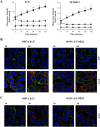Outer Membrane Vesicles from the Probiotic Escherichia coli Nissle 1917 and the Commensal ECOR12 Enter Intestinal Epithelial Cells via Clathrin-Dependent Endocytosis and Elicit Differential Effects on DNA Damage
- PMID: 27487076
- PMCID: PMC4972321
- DOI: 10.1371/journal.pone.0160374
Outer Membrane Vesicles from the Probiotic Escherichia coli Nissle 1917 and the Commensal ECOR12 Enter Intestinal Epithelial Cells via Clathrin-Dependent Endocytosis and Elicit Differential Effects on DNA Damage
Abstract
Interactions between intestinal microbiota and the human host are complex. The gut mucosal surface is covered by a mucin layer that prevents bacteria from accessing the epithelial cells. Thus, the crosstalk between microbiota and the host mainly rely on secreted factors that can go through the mucus layer and reach the epithelium. In this context, vesicles released by commensal strains are seen as key players in signaling processes in the intestinal mucosa. Studies with Gram-negative pathogens showed that outer membrane vesicles (OMVs) are internalized into the host cell by endocytosis, but the entry mechanism for microbiota-derived vesicles is unknown. Escherichia coli strains are found as part of normal human gut microbiota. In this work, we elucidate the pathway that mediate internalization of OMVs from the probiotic E.coli Nissle 1917 (EcN) and the commensal ECOR12 strains in several human intestinal epithelial cell lines. Time course measurement of fluorescence and microscopy analysis performed with rhodamine B-R18-labeled OMVs in the presence of endocytosis inhibitors showed that OMVs from these strains enter epithelial cells via clathrin-mediated endocytosis. Vesicles use the same endocytosis pathway in polarized epithelial monolayers. Internalized OMVs are sorted to lysosomal compartments as shown by their colocalization with clathrin and specific markers of endosomes and lysosomes. OMVs from both strains did not affect cell viability, but reduce proliferation of HT-29 cells. Labeling of 8-oxo-dG adducts in DNA revealed that neither OMVs from EcN nor from ECOR12 promoted oxidative DNA damage. In contrast, flow cytometry analysis of phosphorylated γH2AX evidenced that OMVs from the probiotic EcN significantly produced more double strand breaks in DNA than ECOR12 OMVs. The EcN genotoxic effects have been attributed to the synthesis of colibactin. However, it is not known how colibactin is exported and delivered into host cells. Whether colibactin is secreted via OMVs is an open question that needs further study.
Conflict of interest statement
Figures






References
MeSH terms
Substances
LinkOut - more resources
Full Text Sources
Other Literature Sources

